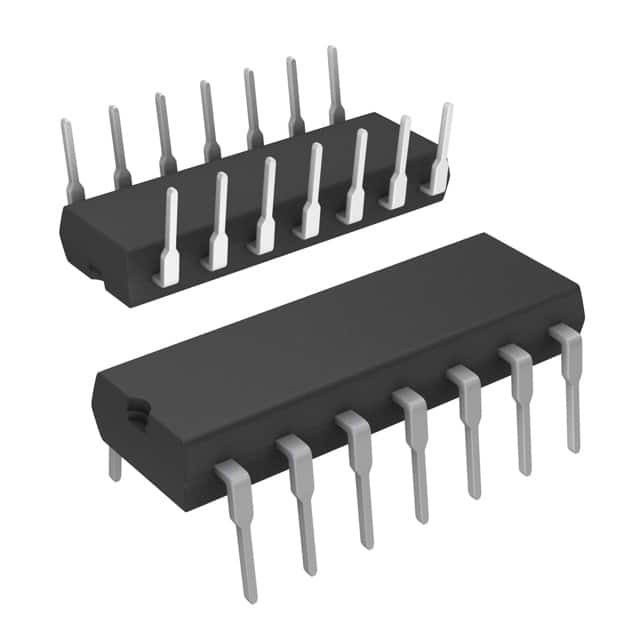Vedi le specifiche per i dettagli del prodotto.

Encyclopedia Entry: 74VHC164N
Product Overview
Category
The 74VHC164N belongs to the category of integrated circuits (ICs) and specifically falls under the family of shift registers.
Use
This IC is commonly used for serial-to-parallel data conversion in various digital applications. It allows for efficient data transfer and manipulation within electronic systems.
Characteristics
- High-speed operation
- Low power consumption
- Wide operating voltage range
- Compatibility with both TTL and CMOS logic levels
Package
The 74VHC164N is typically available in a 14-pin dual in-line package (DIP), which facilitates easy integration into circuit boards.
Essence
The essence of the 74VHC164N lies in its ability to convert serial data into parallel format, enabling efficient data processing and control within digital systems.
Packaging/Quantity
This IC is commonly sold in reels or tubes, containing a specific quantity of units per package. The exact packaging and quantity may vary depending on the supplier.
Specifications
- Supply Voltage Range: 2.0V to 5.5V
- Input Voltage Range: 0V to VCC
- Output Voltage Range: 0V to VCC
- Operating Temperature Range: -40°C to +85°C
- Maximum Clock Frequency: 100 MHz
- Number of Shift Register Stages: 8
Detailed Pin Configuration
The 74VHC164N features 14 pins, each serving a specific function:
- Serial Data Input (DS)
- Clock Input (CP)
- Master Reset Input (MR)
- Parallel Data Outputs (Q0-Q7)
- Ground (GND)
- Serial Data Output (Q7S)
- Clock Enable Input (CE)
- Power Supply Voltage (VCC)
Functional Features
- Serial-to-parallel data conversion
- High-speed operation for efficient data transfer
- Compatibility with both TTL and CMOS logic levels
- Master reset functionality for clearing the shift register
- Clock enable input for controlling data transfer
- Multiple parallel data outputs for flexible integration into digital systems
Advantages and Disadvantages
Advantages
- High-speed operation allows for rapid data processing
- Wide operating voltage range enhances compatibility with various systems
- Low power consumption contributes to energy efficiency
- Compatibility with both TTL and CMOS logic levels simplifies integration
Disadvantages
- Limited number of shift register stages (8)
- Lack of built-in error detection or correction mechanisms
Working Principles
The 74VHC164N operates based on the principle of serial data shifting. It receives a stream of serial data through the DS pin and uses clock pulses from the CP pin to shift this data through its internal shift register. The converted parallel data is then available at the Q0-Q7 output pins.
Detailed Application Field Plans
The 74VHC164N finds applications in various digital systems, including but not limited to: - Data communication equipment - Industrial automation systems - Consumer electronics - Automotive electronics - Robotics
Detailed and Complete Alternative Models
Some alternative models that offer similar functionality to the 74VHC164N include: - SN74HC164N - CD74HC164E - MC74HC164AN - 74HCT164N
These alternatives can be considered based on specific requirements and availability.
Word Count: 346 words
10 domande e risposte comuni relative all'applicazione di 74VHC164N nelle soluzioni tecniche
Sure! Here are 10 common questions and answers related to the application of 74VHC164N in technical solutions:
Q: What is the 74VHC164N? A: The 74VHC164N is a 8-bit serial-in, parallel-out shift register IC (integrated circuit) commonly used in digital electronics.
Q: What is the purpose of a shift register? A: A shift register allows you to store and shift data bits serially, making it useful for applications such as data storage, data transfer, and control signal generation.
Q: What is the maximum clock frequency supported by the 74VHC164N? A: The 74VHC164N can operate at a maximum clock frequency of typically 100 MHz.
Q: How many input pins does the 74VHC164N have? A: The 74VHC164N has a single serial input pin (SER) and eight parallel output pins (Q0-Q7).
Q: Can I cascade multiple 74VHC164N chips together? A: Yes, you can cascade multiple 74VHC164N chips together to increase the number of available output bits.
Q: What is the power supply voltage range for the 74VHC164N? A: The 74VHC164N operates with a power supply voltage range of typically 2.0V to 5.5V.
Q: Does the 74VHC164N support tri-state outputs? A: No, the 74VHC164N does not have tri-state outputs. The outputs are always active and drive either high or low logic levels.
Q: Can I use the 74VHC164N for level shifting between different voltage domains? A: Yes, the 74VHC164N can be used for level shifting as long as the power supply voltages are within its specified range.
Q: What is the typical propagation delay of the 74VHC164N? A: The typical propagation delay of the 74VHC164N is around 4.5 ns.
Q: Are there any specific application notes or reference designs available for the 74VHC164N? A: Yes, the manufacturer of the 74VHC164N typically provides application notes and reference designs that can help you understand and implement the IC in your technical solutions.
Please note that the answers provided here are general and may vary depending on the specific datasheet and manufacturer's documentation for the 74VHC164N.

